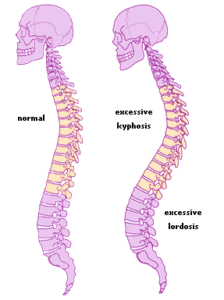 Sounds funny doesn’t it? Well, you have it! If you’ve ever looked at the human spine from the side, It’s not perfectly straight. In order to act like a shock absorber, you spine has three curves: one that rounds in at the neck (cervical lordosis), one that rounds out near the top (thoracic kyphosis), and a second that rounds in near the bottom (lumbar lordosis). Together, these help make your spine sort of like a spring This helps prevent you from injuring your spine by cushioning the impact of standing, walking, sitting, and jumping.
Sounds funny doesn’t it? Well, you have it! If you’ve ever looked at the human spine from the side, It’s not perfectly straight. In order to act like a shock absorber, you spine has three curves: one that rounds in at the neck (cervical lordosis), one that rounds out near the top (thoracic kyphosis), and a second that rounds in near the bottom (lumbar lordosis). Together, these help make your spine sort of like a spring This helps prevent you from injuring your spine by cushioning the impact of standing, walking, sitting, and jumping.
 The normal angle for the thoracic kyphosis is 20-45 degrees. Anything greater than a 45 degree angle is known as hyper-kyphosis and can cause various problems as the angle increases. We’ve all known someone who’s grandma has a hump. This is commonly seen in grandma.jpgthose elderly with osteoporosis when their spinal bones become fragile and compress, creating an excessive curve in their back. Hyper-kyphosis can also be caused by: chronic poor posture, muscle weakness, genetic factors, degenerative disc disease, etc. Those with a positive diagnosis often report pain and stiffness in the back. In more severe cases, decreased mobility can be experienced. Treatments often include a variety of different manual therapies including physical therapy and chiropractic. Physical therapy for kyphosis will often also include a strong exercise regimen that will strengthen the weakened muscles of the back and attempt to restore proper posture to the spine. Bottom line: you don’t have to live with a hunch back!
The normal angle for the thoracic kyphosis is 20-45 degrees. Anything greater than a 45 degree angle is known as hyper-kyphosis and can cause various problems as the angle increases. We’ve all known someone who’s grandma has a hump. This is commonly seen in grandma.jpgthose elderly with osteoporosis when their spinal bones become fragile and compress, creating an excessive curve in their back. Hyper-kyphosis can also be caused by: chronic poor posture, muscle weakness, genetic factors, degenerative disc disease, etc. Those with a positive diagnosis often report pain and stiffness in the back. In more severe cases, decreased mobility can be experienced. Treatments often include a variety of different manual therapies including physical therapy and chiropractic. Physical therapy for kyphosis will often also include a strong exercise regimen that will strengthen the weakened muscles of the back and attempt to restore proper posture to the spine. Bottom line: you don’t have to live with a hunch back!
If you, or a loved one, are suffering from back pain associated with this, contact us today for a free consultation! Stay Well.
